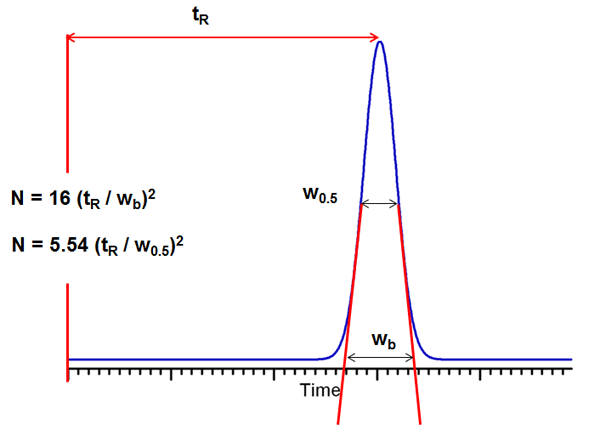Q: I have just developed a gradient HPLC method and need to set the acceptance criteria for system suitability. The column efficiency is one of the measurements we usually include in system suitability, but I don’t know which peak I should use to measure the efficiency. Can you help me?
JWD: Let’s review how we measure column efficiency (also called column plate number, N) under isocratic conditions. Most of us use one of the two formulas shown in the figure. We can use the baseline peak width, which is determined by measuring the distance at the baseline, wb, between tangents drawn to the sides of the peak. This is divided into the retention time, tR, squared, and multiplied by 16. Because drawing tangents is not convenient without printing the chromatogram, a common alternative is to measure the width at half the peak height, w0.5, and performing the same calculation with the exception of multiplying by 5.54 to account for the normal difference between the baseline and half-height width of a Gaussian peak. This also is the way most data systems calculate N. The plate number should be constant throughout the chromatogram, although early eluted peaks usually have somewhat smaller values due to extra-column effects. It really doesn’t matter which peak you choose for this measurement, but most workers choose to use one of the active ingredients of a pharmaceutical mixture or the target compound for a forensic, environmental, or chemical analysis method.
Now let’s switch to gradients. With gradient elution, all the peaks in the chromatogram have approximately the same peak width, whereas with isocratic separation, the peak widths increase with retention time. What happens if we apply the isocratic plate number calculation to gradients? You can see that if retention increases while the peak width remains constant, the calculated plate number increases. This simply is not possible, so it tells us that we can’t calculate gradient column efficiency in this manner.

Figure 1
There isn’t an easy way to calculate N for gradients, so we have to take a different approach. Some workers use the isocratic formula for N with gradients, but always use it with the same peak. This still does not give a correct value of N, but at least it is consistent, so you should be able to observe when the plate number degrades. A better way is to use the peak width or width at half-height as a measure of column performance in gradient elution. You should still specify which peak to use for the measurement, but otherwise the peak width gives similar information about column quality for gradients as the plate number does for isocratic conditions. I would put a new column in the system and measure the peak width for the target peak under normal operating conditions. Then either watch the width as the column ages or put an aged column in and measure the peak width. Using these data, you should be able to put a limit on the peak width and use this as one of your system suitability criteria for gradient methods.
This blog article series is produced in collaboration with John Dolan, best known as one of the world’s foremost HPLC troubleshooting authorities. He is also known for his research with Lloyd Snyder, which resulted in more than 100 technical publications and three books. If you have any questions about this article send them to TechTips@sepscience.com




